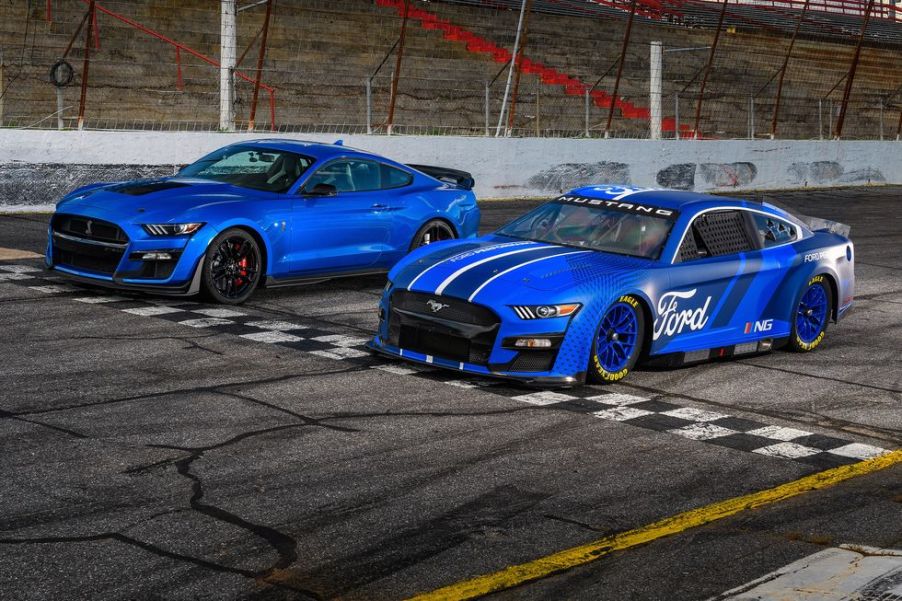
Revealed: The Next-Gen Ford, Chevy, Toyota Nascar Racers
NASCAR has finally done something positive with its Cup cars. Today it revealed its “next-gen” 2022 race cars and though the resemblance to real cars is obvious, there is a lot more NASCAR is changing. All of it looks like for the better, rather than chasing its tail as it seems to perpetually be doing. Here’s a long look at the changes.
Body changes allow manufacturers to better represent production cars

First, the body changes allow the manufacturers to make better representations of the production cars they’re meant to be like. Patterned to loosely resemble Ford’s Mustang, Chevy’s Camaro, and Toyota’s Camry, they are a vast improvement over the previous “sticker” designs.
One thing gone is the asymmetrical body design. Previous bodies pulled out on the passenger side while the driver’s side stayed relatively flat. This was designed to increase side force.

The current Cup bodies are made from sheet metal. These new NextGen cars will have carbon fiber bodies. Making contact with the wall or another car should have less dire consequences-at least now panels can be swapped out rather than the entire body side.
Overall length has been reduced by six inches

Though the wheelbase remains the same the overall length has been reduced by six inches. The roof is 1.5 inches shorter, too. And the overall width has increased by 1.6 inches as well.
In years past the better-funded teams spent generously on aerodynamic testing to create better aero underneath the body. Now a carbon fiber undertray creates a smooth, belly pan-like undercarriage. At the rear is a diffuser to manage the air out the back.
These diffusers will vary from track to track, dictated by NASCAR. Air management underneath the cars is now in NASCAR’s hands. And to better extract heat in the engine compartment, NACA ducts are placed on the hood.
Technique Inc. will make the center cage, front and rear substructures

In the past, each team had specialized shops that created the tube frames the cars had. Now, all of that has been taken over by Technique Inc. The company will make the center cage and both the front and rear substructures.
In the event of an accident, the front and/or rear substructures can be unbolted and replaced. No more cutting and welding a new frame. This should save teams money and potential cheating.
Suspensions will see an Öhlins four-way adjustable damper at each corner. Now a single unit can be used for different tracks. Adjustments will be handled on pit lane, and spring selection will be dependent on which track the vehicle will race on.
A big change underneath is an independent rear suspension

A big change underneath is the independent rear end being allowed for the first time. Infinitely adjustable, with this NASCAR has taken away the in-car driver adjustments. Rear spring rates will still be accessible in the pits during the race. Also, all cars will now feature rack-and-pinion steering.
Thankfully, engines will still be allowed to be massaged by the teams. And they remain pushrod V8 engines. The exhaust system will no longer have a crossover pipe. Instead, the engine’s left side spent gasses exit through the left, and the right exhaust exits on the right.
The X-Trac five-speed transaxle will replace the four-speed transmission. Gear swaps for road courses will be much easier to perform. The transaxle also leaves room for an eventual hybrid powertrain. When that might happen has not been announced by NASCAR.
18-inch forged aluminum wheels replace the previous 15-inch wheels

Gone are the five-lug 15-inch wheels. They’re replaced with 18-inch forged aluminum wheels. In addition, the lug nuts are gone and a center-lock, single nut wheel is required. Some of that pit row drama will be history, but pit changes should move quicker.
Wider 18-inch tires from Goodyear are another change. This also allows for larger brakes to fit. And the larger wheels and shorter tires look so much better. So this is a functional but also a cosmetic change for the better.
All of these changes and more will make their debut at the 2022 Daytona 500. This first race should be a spectacle of speed and skill. We can’t wait.



